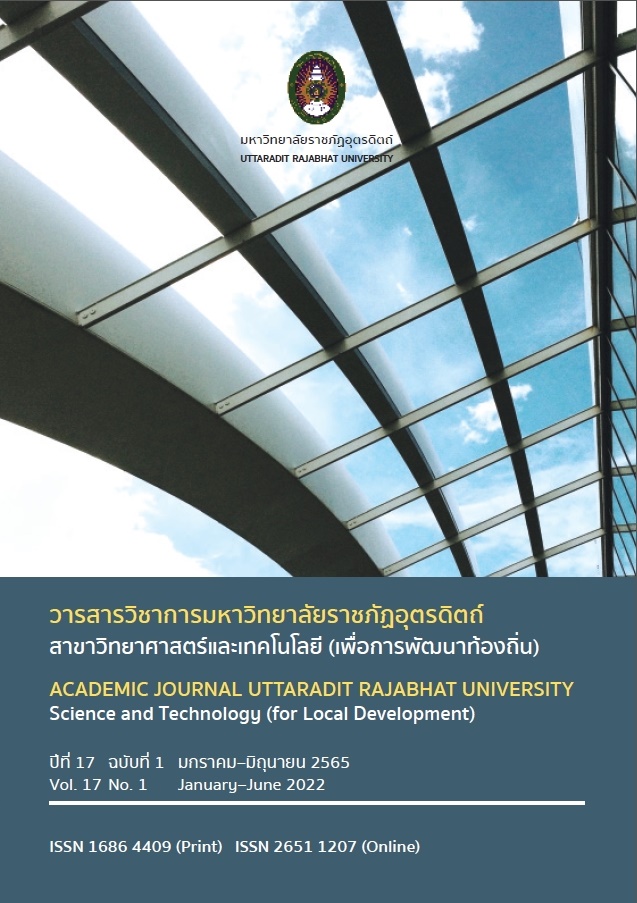NATURAL FIBER-BASED POLISHING PAD FOR CHEMICAL MECHANICAL POLISHING OF SAPPHIRE SUBSTRATE
Main Article Content
Abstract
This research aims to create and to test a mechanical property, including a performance of natural fiber-based polishing pad produced by using fibers of coconut coir and rice straw mixed with polyurethane. After sizing, those fibers will be mixed with polyurethane at ratios of 5, 7.5, and 10 phr to form as polishing pad before measure a hardness and test a performance in sapphire chemical mechanical polishing. The experiment results showed that natural fiber-based polishing pads could be formed and stable. The natural fibers in polishing pads distributed all contact surface. Hardness of natural fiber-based polishing pads was smaller than conventional pad in range of 3.6–11.7%. Polishing results revealed that polishing pads made from coconut coir mixed with polyurethane at mixing ratio of 10 phr, and rice straw fiber mixed with polyurethane at mixing ratio of 7.5 phr could produce surface roughness of sapphire as 1.0 and 1.3 nm, respectively. Both pads produced the similar highest material removal rate of 0.015 m/hr or 30% of polishing result obtained conventional pad. These results indicate that both fibers able to be used as a material to manufacture a polishing pad for adding value and reducing the waste from the agricultural.
Downloads
Article Details

This work is licensed under a Creative Commons Attribution-NonCommercial-NoDerivatives 4.0 International License.
References
จักกฤษณ์ พนาลี, พันธ์ศักดิ์ พ่วงพงษ์, และ ธีรภัทร์ รอดคลองตัน. (2559). การศึกษาและออกแบบเฟอร์นิเจอร์สำนักงานจากเส้นใยกาบมะพร้าว. รมยสาร, 14(ฉบับพิเศษ), 165–172.
จินดามณี นิสยันต์ และ อภิชาติ อาจนาเสียว. (2563). การเพิ่มประสิทธิภาพโรงสีข้าวหอมมะลิ. ใน การประชุมวิชาการเสนอผลงานวิจัยระดับบัณฑิตศึกษา ครั้งที่ 12, (น. 328–336). ขอนแก่น: มหาวิทยาลัยขอนแก่น.
ทศพร ศรีวรกุล, กุลทัศน์ สุวัฒพิพัฒน์, จันทร์ฉาย ทองปิ่น, นวพันธุ์ ภู่ภักดี, วรุต ธรรมวิชัย, และ ชีวิตา สุวรรณชวลิต. (2559). การเตรียมเส้นใยเซลลูโลสจากเส้นใยมะพร้าวด้วยกระบวนการเคมีเพื่อใช้เป็นสารเสริมแรง. วารสารวิชาการ Veridian E-Journal Science and Technology Silpakorn University (สาขาวิทยาศาสตร์และเทคโนโลยี), 3(5), 206–216.
ปราโมทย์ วีรานุกูล, กิตติพงษ์ สุวีโร, และ อิทธิ วีรานุกูล. (2561). ผลิตภัณฑ์แผ่นฝ้าเพดานผสมขุยมะพร้าวที่มีสมบัติความเป็นฉนวนป้องกันความร้อน. วารสารวิศวกรรมศาสตร์ราชมงคลธัญบุรี, 16(2), 129–138.
ผกามาศ ชูสิทธิ์ และ กิตติพงษ์ สุวีโร. (2558). การใช้ขุยมะพร้าวเพื่อเสริมแรงต้านทานแรงดึงของผลิตภัณฑ์แผ่นยางธรรมชาติ. สืบค้น 11 สิงหาคม 2564, จาก https://repository.rmutp.ac.th/bitstream/handle/123456789/2061/TECH_59_03.pdf?sequence=1&isAllowed=y
วันดี ธรรมจารี. (2556). การดัดแปรพื้นผิวเส้นใยธรรมชาติ. สืบค้น 11 สิงหาคม 2564, จาก http://www.tpa.or.th/publisher/pdfFileDownloadS/tn227a_p061-64.pdf
สำราญ พิมราช, เหล็กไหล จันทะบุตร, พรพิษณุ ธรรมปัทม์, และ สุนันท์ บุตรศาสตร์. (2563). ความสัมพันธ์ระหว่างการสะสมปริมาณซิลิคอนกับการให้ผลผลิตของข้าว. วารสารเกษตรพระวรุณ, 17(2), 209–222.
Bahr, M., Sampurno, Y., Han, R., & Philipossian, A. (2017). Slurry Injection Schemes on the Extent of Slurry Mixing and Availability during Chemical Mechanical Planarization. Micromachines, 8(6), 170–182.
Cui, Y., Niu, X., Zhou, J., Wang, Z., Wang, R., & Zhang, J. (2019). Effect of Chloride Ions on the Chemical Mechanical Planarization Efficiency of Sapphire Substrate. ECS Journal of Solid State Science and Technology, 8(9), 488–495.
El-Adly, R. A., Yossef, M. A., Modather, F. H., Ismail, E. A., & Abbas, D. M. (2015). Biogrease Based on Biochar from Rice Straw and Waste Cooking Oil. International Journal of Advances in Pharmacy, Biology and Chemistry, 4(1), 91–97.
Greeshma, P., & Joseph, M. (2011). Rice Straw Reinforcement for Improvement in Kuttanad Clay. In Indian Geotechnical Conference, (pp. 449–452). Kochi: India.
Kong, H. et al. (2016). Polydisperse Spherical Colloidal Silica Particles: Preparation and Application. Chinese Physics B, 25(11), 118202-1–118202-6.
Malaluan, L. E., Sescar, W. J. E., & Sescar, J. J. E. (2019). Lignocellulosic Plant Fibers (lpf) for Concrete Masonry Blocks (cmb): an Inspiration to Innovation Response to the 21st Century’s Endeavor for Environmental Challenges. International Journal of Scientific Research, 10(01(F)), 30656–30666.
Natsa, S., Akindapo, J. O., & Garba, D. K. (2015). Development of a Military Helmet using Coconut Fiber Reinforced Polymer Matrix Composite. European Journal of Engineering and Technology, 3(7), 55–65.
Naveen, P. N. E., & Prasad, R. V. (2013). Evaluation of Mechanical Properties of Coconut Coir/Bamboo Fiber Reinforced Polymer Matrix Composites. International Journal of Metallurgical & Materials Science and Engineering (IJMMSE), 3(4), 15–22.
Nazerian, M., & Sadeghiipanah, V. (2013). Cement-bonded Particleboard with a Mixture of Wheat Straw and Poplar Wood. Journal of Forestry Research, 24, 381–390.
Pureon. (n.d.). Suba™ 600 Felt Polishing Pad. Retrieved August 15, 2021, from https://pureon.com/products/polishing-pads/suba-600
Sanjay, S., & Rajeev, C. (2015). Effect of Coconut Fibre Ash on Strength Properties of Concrete. International Journal of Engineering Research and Applications, 5(4), 33–35.
Sansuwan Chansatarpornkul. (2019). Development of Organic Fibers in the Polishing Pad for Chemical Mechanical Polishing of Sapphire. Master Thesis, Graduate School of Computer Science and System Engineering, Kyushu Institute of Technology.
Sapphire. (n.d.). Retrieved August 15, 2021, from https://logitech.uk.com/whatwe-offer/by-material/sapphire/
Vovk, E. A., Budnikov, A. T., Dobrotvorskaya, M. V., Krivonogov, S. I., & Dan’ko, A. Y. (2012). Mechanism of the Interaction between Al2O3 and SiO2 during the Chemical-mechanical Polishing of Sapphire with Silicon Dioxide. Journal of Surface Investigation X-ray Synchrotron and Neutron Techniques, 6(1), 115–121.
Wang, H., Zhang, Z., & Lu, S. (2018). Study of Several Silica Properties Influence on Sapphire CMP. Journal of Electrical Engineering and Technology, 13(2), 886–891.
Zhou, Y., Pan, G., Gong, H., Shi, X., & Zou, C. (2017). Characterization of Sapphire Chemical Mechanical Polishing Performances using Silica with Different Sizes and their Removal Mechanisms. Colloids and Surfaces A: Physicochemical and Engineering Aspects, 513, 153–159.
Zhou, Y., Pan, G., Shi, X., Gong, H., Xu, L., & Zou, C. (2015). AFM and XPS Studies on Material Removal Mechanism of Sapphire Wafer during Chemical Mechanical Polishing (CMP). Journal of Materials Science: Materials in Electronics, 26, 9921–9928.


